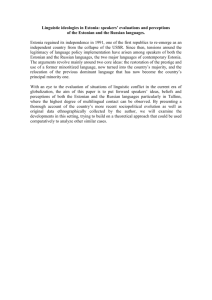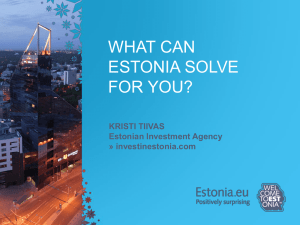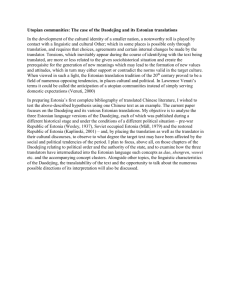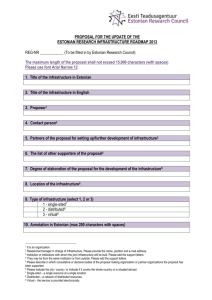The Influence of English Mass Culture on Estonia - Salto
advertisement
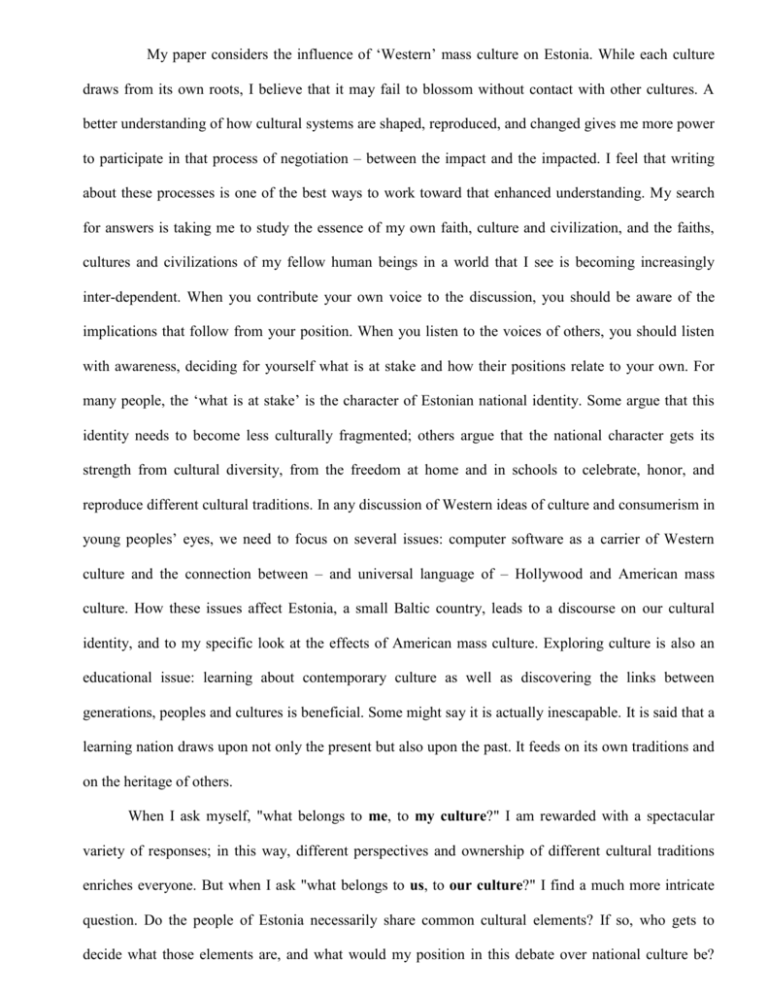
My paper considers the influence of ‘Western’ mass culture on Estonia. While each culture draws from its own roots, I believe that it may fail to blossom without contact with other cultures. A better understanding of how cultural systems are shaped, reproduced, and changed gives me more power to participate in that process of negotiation – between the impact and the impacted. I feel that writing about these processes is one of the best ways to work toward that enhanced understanding. My search for answers is taking me to study the essence of my own faith, culture and civilization, and the faiths, cultures and civilizations of my fellow human beings in a world that I see is becoming increasingly inter-dependent. When you contribute your own voice to the discussion, you should be aware of the implications that follow from your position. When you listen to the voices of others, you should listen with awareness, deciding for yourself what is at stake and how their positions relate to your own. For many people, the ‘what is at stake’ is the character of Estonian national identity. Some argue that this identity needs to become less culturally fragmented; others argue that the national character gets its strength from cultural diversity, from the freedom at home and in schools to celebrate, honor, and reproduce different cultural traditions. In any discussion of Western ideas of culture and consumerism in young peoples’ eyes, we need to focus on several issues: computer software as a carrier of Western culture and the connection between – and universal language of – Hollywood and American mass culture. How these issues affect Estonia, a small Baltic country, leads to a discourse on our cultural identity, and to my specific look at the effects of American mass culture. Exploring culture is also an educational issue: learning about contemporary culture as well as discovering the links between generations, peoples and cultures is beneficial. Some might say it is actually inescapable. It is said that a learning nation draws upon not only the present but also upon the past. It feeds on its own traditions and on the heritage of others. When I ask myself, "what belongs to me, to my culture?" I am rewarded with a spectacular variety of responses; in this way, different perspectives and ownership of different cultural traditions enriches everyone. But when I ask "what belongs to us, to our culture?" I find a much more intricate question. Do the people of Estonia necessarily share common cultural elements? If so, who gets to decide what those elements are, and what would my position in this debate over national culture be? Would a greater body of shared cultural knowledge among all Estonians enhance communication and intercultural understanding? We should not be swayed by claims like – ‘My country is right’, ‘My people are the greatest in history,’ and ‘My faith is the only true faith’. Who can legitimately speak for a particular culture? Whose voice counts? In whose name is the dialogue conducted? Do we need to accept that there are multiple valid cultural perspectives and that two such perspectives can both be valid even though they might contradict one another? The questions I ask about our culture are questions about deep personal meanings. Some Estonians say, ‘Do not interfere in our affairs; you are Westerners and thus you represent just another cultural subset and have no right to make universal claims.’ I think we need to remind ourselves that there are Western intellectuals, and a number of them at that, who have adopted a position of what we call cultural relativism, which means considering the plurality of cultures positive to the point of denying the universal character of human rights. With growing global inter-dependence, separate autonomous phenomena are declining. The West is telling us: ‘we shall be universal, but be universal like me’. Though not the reasoning of all Westerners, such is the global discourse and practice. I am sure that no civilization by itself can claim to represent all humanity nor to assume full responsibility for it. Neither can one single civilization claim exclusive rights to provide a universally valid vision of how to be a good human being and how to live wisely in today’s world. A language is undoubtedly an integral part of culture, and vice versa, so one cannot separate them without some clear effects. Language expresses, embodies, and symbolizes cultural reality: people view their language as a symbol of their social identity, and this is an especially poignant point for a country like Estonia, force-fed a diet of Russian language and culture for so many years. How do we, Estonians, identify with our language and its uniqueness, and why do we often fret about the loss of our cultural identity? We crave and loathe the same things at the same time: Wanting to be more “Western” in our lifestyles, while retaining our “Estonian” character in our languages and attitudes. “What is to be done?” Today, the problem facing a pluralistic and democratic society like Estonia is how it will maintain its linguistic diversity. I am sure that we must learn and use two languages in addition to our mother tongue. I, for example, speak English, Estonian and Russian fluently, and I have started learning French. If it is a fact that languages open the door to other cultures, it is just as true to say that an absence of linguistic ability can be a severe handicap. What can be done to steer the right course between authoritarian linguistic policies, which are incompatible with our liberal conception of culture and education, and a laissez-faire policy that would lead to a misconceived homogenization under the banner of globalization, in which even my British and American friends would be unable to recognize their own identity? If present trends continue, people across the world will all be eating hamburgers, wearing jeans and listening to Western rock music at the expense of their own local customs and traditions. Similarly, as cultural diversity disappears, the diversity of global languages will disappear, English becoming the sole vehicle of communication. Exposure to foreign mass culture is sometimes seen as having an adverse effect on the structure and vocabulary of the spoken and even written language. Characteristically, as a small nation, the Estonian identity is closely connected to its language. Estonian is one of the world's smallest cultural languages to include contemporary terminology for all major fields of life. Recently, there has been a lively debate over the needs and possibilities to protect the national language from foreign influence. We borrow English words in ever increasing numbers, not merely terms from trade and commerce, but words of a much more important kind. English contributions to the Estonian lexicon have become more numerous and widespread. The interface between English and Estonian became even closer due to new means of communication. It is quite difficult to enumerate all the fields of human activities of Estonia on which English has exercised an influence. The result of English influence is that the Estonian language borrows English loan – words, adapts them, and subsequently integrates them into our daily professional and personal vocabularies. Everyday, we hear words like “OK”, “good”, “shopping”, “pub”, “blockbuster”, “pop singer”, and “computer”. In the Estonian version of the popular TV gameshow “Who wants to be a millionaire?” every contestant uses the English expression “fifty-fifty”. It seems ironic, then, that some parts of Estonian syntax show a 50:50 balance between ‘own’ Estonian and loan–stems. Estonia is greatly influenced by English mass culture and it is definitely the youth of today who are being exploited by it. We drink Coca Cola, wear blue jeans, watch Hollywood movies, listen to American music, use Microsoft software, and eat fast food. We do all these things daily. When you visit schools in Estonia, you will find students listening to music on their CD players: it is mostly American pop music from singers like Britney Spears, Christina Aquilera, Ricky Martin, Ciara and Eminem. Everywhere you go in this small country, which used to be behind the Iron Curtain, everyone knows about Madonna, Michael Jackson, Louis Armstrong and other icons of American music. Another field where the influence of English mass culture has been felt is fashion. Young people especially like American fashions. If you visit Tallinn, you can see many young students wearing the same brands – 96 New York jeans, Guess, Prada – that you might see in Texas or Tennessee. Is it in Kohtla-Järve or Kansas that you might hear a teenaged boy saying, “Look, I'm wearing a Tommy shirt and Polo pants?” ‘Viru Keskus’, the "American style" shopping mall in Estonia, has become very popular among young people as they may buy there any global brand. I assume that this is a ‘Western’ idea: to make young people believe that brands stand for something special, and convince them that they also will become special if they buy and wear a product that carries a certain name. Many young people define themselves less by their social class or ethnic origin than by their personal brand set: the jeans they wear and the labels on their clothes. They try to imitate the lifestyles of the rich and famous. Young people feel that they are on the way to pursue an American Dream if they have prestigious and costly products, and hope to establish their social position through them. Yet, others think that the brands are the evil of a consumer society, enriching their corporate owners by exploiting people’s insecurities and desires; the brands represent a triumph of consumerism over human values. The older generation assumes that our nation of workaholics has become a nation of ‘shopaholics.’ Nowadays, more and more Estonian families, like many American ones, find themselves struggling to pay off their credit card debt, a modern convenience which helps people buy anything, even the things they cannot really afford. Our food and restaurant activity is one area that has been influenced a lot by American-style fast food restaurants. Years ago, America’s foods began to affect the rest of the world – not only raw staples such as wheat and corn, but with a new American cuisine that spread worldwide. American emphasis on convenience and rapid consumption is best represented in fast foods such as hamburgers, french fries, and soft drinks, which virtually every American has eaten. By the 1960s and 1970s, fast foods became one of America's strongest exports as franchises for McDonald’s and Burger King spread throughout Europe and other parts of the world, including Estonia. Traditional meals cooked at home and consumed at a leisurely pace – common in the rest of the world, and once common in the United States – gave way to quick lunches and dinners eaten on the run as other countries mimicked American cultural patterns. This is strange in my country with traditional food, but it is necessary in a modern society characterized by time binds. Many of us believe, however, that our traditional food has to be saved from such influences. Now there is a tendency to open fast food places, but with local and regional products so that our traditions are not lost. After the initial excitement of trying other kinds of foods, we now think that Estonian products are healthier and should be served even in a frugal lunch. Perhaps, then, it is no surprise that McDonald's is less successful in Estonia than it is in other countries; the culture of the Estonian people is oriented to eating at home with the exception of the four or five big cities in the country. Another aspect of strong impact of English mass culture on Estonia is the omnipresent computer. I cannot imagine my life without a computer and the Internet. The personal computer has already become one of the most ubiquitous appliances in today’s modern world. The Internet has led directly to the creation of many Estonian companies. It is my contention that computer software design is deeply influenced by American and Western culture, and therefore reflects its values and priorities. These very same values, embodied in the Microsoft Office suite, are “downloaded” into cultures all around the world. In Estonia, as in all countries, English mass culture guides the way we create documents, surf the Web, send e-mail, and exchange information in a multitude of different ways. Most PCs are usually loaded with the same basic kinds of American software: an Internet browser, an e-mail client, and at least some sort of productivity software, most likely a word processor. This means that thousands of Estonians, like millions of people all over the world, whether at home, the office, Internet cafes, or other venues, are constantly working, communicating, or entertaining themselves through software, while at the same time they slowly internalize the thought processes, priorities, and values embedded in the applications they use. As computer and software usage grows among cultures worldwide, it will become increasingly important to understand how software can act as a carrier of culture, and what effect, if any, this can have on other cultures. Since huge amounts of software language, applications, and associated hardware were initially created in the United States, I believe that American cultural values are reflected in the design and functionalities of such applications. I constantly use ‘Microsoft Office’, which I find very practical. I think that one of the most widely distributed software applications in the world – Microsoft Office suite – reflects. I assume that the potential impact of software to influence cultural traits and values may be greater than that of the transient trends of popular culture. My ancestors would marvel at today’s sophisticated, rapidly changing era. They would marvel at the Internet and the way every corner of the world can be drawn together instantly. They would see a world where state-of-the-art information technologies, development of telecommunications, global economic processes, and migrations bring about more frequent meetings of civilizations, embracing larger groups of people. Our older generation thinks that a revolution in the area of communication and the development of Internet mean the wider spread of the ideological and cultural influence of the West – and not the entire West, but a small group of countries that possess certain technological resources. But I assume that technological ideas spread rapidly, and this means that no country holds a monopoly on them. The contemporary world, dominated by modern information technologies, not only forces closer dialogue among civilizations, but also gradually turns its civilization into one of dialogue. Globalization is expanding in today’s world. Distances are shrinking and relations among peoples are intensifying. National barriers are breaking down. I can just as easily email a friend in Kansas as one in Kenya or Kazakhstan. Our economies are becoming intertwined as businesses span national boundaries, and many products involve parts or ingredients from several countries. Was the computer I used to type this assembled in Estonia, Finland, China or the U.S.? Increasingly, we in the developed world are becoming one ‘human family’, strongly inter-dependent on one another. We have to sacrifice a widely made assumption that all civilizations are necessarily good. Civilizations commonly over-exploit their environments, often to the point of self-destruction. New barbarians abjured civilization altogether – communists and Nazis, for example, who repudiated humane values in the rush to exterminate whole races and cultures. Mikhail Tukhachevsky, a general of the Russian Red Army, threatened ‘to make the world drunk ... to enter chaos and not to return until we have reduced civilization to ruins.’ He wanted Moscow to become ‘the centre of the world of the barbarians.’ His programme for progress included burning all books ‘so that we can bathe in the fresh spring of ignorance.’ My grandparents and relatives are Finns, and they suffered terribly from the Soviet regime: after the Second World War, they were sent to the concentration camps in Siberia and Pskov, where many of them perished. Many Estonian families will tell you the same story, and for many of them, accepting something that is essentially non-Estonian is a problem. Loss of sovereignty and identity problems – these are particularly sore issues for us today. Many people have asked: "Why are we forced to jump from one union to another?" It should be remembered that upon the collapse of communism, when the ice of Yalta melted, there were reasons to fear the revival of ethnic and civilization clashes. I think that little progress has been made on the cultural front after the initial wave of enthusiasm that followed the collapse of the Soviet Empire and the fall of the Berlin Wall. Our near past contains sad experiences, haunting and yet to be forgotten. But time is perpetual and people – especially my young, new generation – are beginning to recognize that bad days of the Soviet Union need not haunt us; rather, they should inspire us to a dialog. We need not heed the call, “Carthage must be destroyed!” No Carthage should be ever reduced to ruins. No culture’s foundations should be so shattered, and no nation’s soil should be so ravaged that nothing can ever grow in it. But in saying this, are we saying that, “Carthage must be saved?” Are we saying that some of the characteristics of the bad Soviet days must be saved? How, I wonder, would this fall upon the ears of those thousands of Estonians who were deported to, and died in, Siberia? We live in Estonia between two poles of anxiety. One is in the open: the fear of Russia and of “Russian” things we know, such as hunger, bombs, crime and violence, mass deportation, Chechnya, and concentration camps. It is a publicly accepted, undeniable fear. During the Soviet regime, cultural policies were geared for Russification, and in my homeland, their real aim was to destroy the basis of Estonian national identity and Estonian culture. Resistance was most pronounced in cultural life. A distancing from the stable patterns of post-totalitarianism began in Estonia’s cultural life and policies in 1988, when representatives of the cultural field voiced their views for the first time in public against the environmental and nationality problems created by Soviet rule. To counteract influences from the East, there was a renewed interest in Western culture and information: popular radio stations like Radio Free Europe, Voice of America and the BBC World Service. The other pole of anxiety is the fear of losing our cultural identity. Estonia is a small country that has struggled through the centuries to maintain its cultural identity in the face of overwhelming and often brutal external pressures. The Preamble of the Estonian Constitution of 1992 proclaims, "the preservation of the Estonian nation and culture" among the main functions of the independent state. Support for identity, the openness for cultural influences from other parts of the world, and support for creativity and concern for participation in cultural life have all become a part of Estonian cultural policy. Estonia has stood on the cultural dividing line between Eastern and Western Europe for centuries. The impact that such a position has had on the characteristic features of the culture is tremendous. Our cultural scene is distinguished by many peculiarities and is a highly complicated way of existence for a small nation. Being open to the sea and trade due to its geographical position, Estonia has been characterized throughout the centuries by a large variety of cultures. Bearers of different cultures arrived here at different times and for different reasons. During the 16th and 17th centuries, Catholicism vied with Protestantism, the latter winning the ultimate victory. This led Estonians to a focus on literary culture and the written word. Church has never been particularly important to Estonians, as it is in Catholic or Orthodox cultures. Hence, we do not have over – ritualized attitudes towards the state, religion or culture. After Estonian re-independence in 1991, the consumption of culture quickly acquired the same structure as that of the western world. The younger generation saw English mass culture as a true blessing and safeguard of freedom. But many adults fretted that Estonians were losing their identity; they were also concerned because many young people didn’t even know about the traditional Estonian holidays. The older generation wants young people to feel a responsibility to preserve our culture. No one can doubt the present-day significance of American popular culture in Estonia. Entertainment such as movies, music, and television programs hold a special appeal to young people. The American moviemakers obviously know what audiences like and enjoy to watch, and I am sure that the cinemas here would be empty without Hollywood. The American movie industry has been popular in Estonia since the 1990s and – in contrast to McDonald’s – young people don't think that Estonia is losing its cultural identity by watching exported movies from the United States. I think that American movies are a good way to spread American culture because often people are influenced by what they see on the “silver screen.” The question relates also to television as a powerful means of sharing and expressing cultural diversity. Most of the entertainment programs and documentaries we watch on TV are from America, and most of the movies we go to are made in Hollywood. Sometimes, the movie theaters are swamped with low-cost American films – violent action films. This type of dominance creates a negative effect on the young generation and can increase crime. In this situation, we should recognize that the spread of culture to another country can also spread the problems inherent therein. Television and other mass media broadcast a portrayal of a privileged American lifestyle that many Estonians hope to imitate. People all over the world view American television programs. American television has become such an international fixture that American news broadcasts help define what people in other countries know about current events and politics. The debate about the power of TV to influence people's behavior and beliefs has been going on ever since the medium became widely popular in the West in the 1950s. Many people in our country are worried about the impact of the ‘Western-style’ TV on social behavior, particularly crimes of violence; its effects on the political process; and whether it causes a deterioration in cultural standards. A lot of Estonians say that the growing size of the American media conglomerates threatens the global cultural endowment. American culture has been pervasive in Estonia in the last 15 years. Today, American culture often sets the pace in modern style. While mass media made entertainment available to more people, it also began to homogenize tastes, styles, and points of view among different groups. Like it or not, America has become the dominant cultural source for entertainment and popular fashion, from the jeans and T-shirts young people wear to the music groups and rock stars they listen to and the movies they see. American entertainment is probably one of the strongest means by which American culture influences Estonia, although some people resist this influence because they see it as a threat to their unique national culture. Mass media in Estonia are becoming increasingly Americanized. More channels are devoted to talk shows and pop music, games and quizzes. As the influence of American culture grows around the world, members of local cultures consistently express concern about the integrity and survival of their ways of life. Many Estonians particularly fear the influence of Hollywood films, television, and popular music, which infiltrate their homes through cable, satellite, and the Internet. They see these technologies as powerful carriers of American cultural values, which they fear will erode their own culture, especially amongst the young. When considering Hollywood’s effect, our youth take their cues from the way the Americans – good and bad – are portrayed in the movies. For instance, many Estonian youth begin to dress, talk, and even behave like his or her actor from a particular American television series. Who, fifteen years ago, would have imagined that the American films, television programming, and recorded music which dominate our market could lead to Estonians aping the hip-hop culture with baggy jeans and baseball caps turned backwards? We have to consider carefully how we can benefit from what the world has to offer towards our overall development efforts, without being overwhelmed by negative external influences. Estonia’s unique geographical position at a crossroads of diverse cultures provides a distinguished place for a drive for peace and understanding. I think that my country’s main goal is to create a culture of peace, tolerance and the respect for other traditions and cultures through dialogue and constructive means of understanding and to become the venue of dialogue among different cultures. At the same time, I believe that dividing Europe into ‘Latin’ and ‘Byzantine’ parts, in which only one would be perceived as capable of absorbing European values, is most dangerous. Such a division along the former borders of long-disappeared empires would forever cut off half of Europe from modern integration processes. Who will play the role of supreme judge and interpreter of the truth for the European nations? Many Estonians associate democracy, pluralism and tolerance with the so-called Western cultures. Different European cultural traditions have crossed and enriched themselves. As I understand, the European Union is trying to preserve the unique diversity and character of each national culture, to follow the principle of ‘unification through diversification’ and to consolidate interregional communication and dialogue between civilizations. It means that we are expected to preserve our national identity, thus contributing to cultural diversity in Europe and in the world. I assume that one of the main challenges facing Estonia in its development is assimilating the positive forces of change without losing its unique culture and identity. Many Estonians assume that globalization may provoke anxiety and resistance because it eventually leads to the destruction of traditional ways of thinking, values systems and deep-rooted cultures. But young Estonians believe that globalization may also open an opportunity for development and constructive changes, and it may lead to the formation of an identity among individuals and communities that will be more open and less inclined to prioritize only their own views. I do not believe in insurmountable cultural barriers. I do not think there are boundaries between civilizations, which were formed by a century-long tradition, never to disappear. Time and culture are powerful stabilizers but they may equally forcefully promote changes. Dialogue among civilizations is the fruit of a wide variety of perceptions whose intersecting nature assists a greater grasp and understanding of others. This cultural dialogue has taken on a new meaning in the context of globalization and of the current international political climate. Thinking most broadly, I find some conclusions come immediately and easily to mind: We should promote tolerance, the protection of cultural diversity and of cultural heritage, in order that the peoples of the world may live in peace with each other in a climate of mutual respect. We should foster a positive understanding between cultures, through the discovery of a common heritage and shared values. We must seek what we have in common, namely, codes of understanding. We must learn how to form unity in plurality. At the same time, we must increase our sensitivity so as to respect other’s identities, the need to differentiate ourselves, and different views on the world around and on life. Only then will we be able to avoid the problems, disappointments and dangers that globalization holds in store. If globalization is limited only to its technical, economic and media manifestations, and if it does not produce genuine partnerships between cultures and people, it will be of no avail. If a free movement of ideas, commodities and lifestyles is not equally vested in all societies, barriers will arise that will relegate many people to exclusion. Lack of understanding may pose a substantial threat to the world’s stability and may fuel nationalism and xenophobia. The stronger the cooperation and goodwill among nations, the lesser is the need to spend huge resources on arms and military strategies. In 2005, young Estonians have high expectations about technology: text messaging, cell phones, and doing research on the Internet are our everyday activities, and connectivity is continually increasing. We get news "alerts" as text messages on the same mobile phones that we use to pay for our car parking fees. We shop online, pay online, greet our buddies online, all the while remembering that time is a currency for us. In fact, we, young Estonians, respect and understand time. We know how to use it, and we know what it has done for us. We are busier than ever before. Writing from my hometown in northeast Estonia, this strikes me as one of English mass culture’s most profound influences. As I think about my own, personal perspective – as a young Estonian citizen – it becomes more personal, and the challenges we face seem more profound: How do we preserve our unique culture while embracing the things we need and love? Must I choose between Estonian music and Eminem? Will I even have time to consider this choice, or will it be made for me? I expect that we will never lose the need to co-operate with the United States and the EU on the ways they export their culture to us. But when will “they” see that they need “us” too? No Estonian can be ignorant of what time and the effects of mass cultures have done to us. Centuries of our history reinforce this often-painful memory. Yet, we, Estonians, have survived and regained our independence, and ideally, we will maintain our independence in the European Union, NATO, and everywhere else. We must not lose our independence, which is in fact the main foundation for our culture and its network of social and psychological rituals. At the same time, we want and need to make Estonia culturally and economically attractive abroad, and part of this demands that we accept English mass culture. This time, culture is clearly in the service of economics. But it need not always be so. Our Estonian society is also a society of achievements and therefore, it can progress at the same rapid pace that our technology does. I argue for a happy medium: Where we embrace the things we love from the West, but don’t lose our appreciation for the things that make us special. Perhaps, one day, we will recognize something in “English mass culture” that is quintessentially Estonian and come to speak of the influence of Estonian mass culture on the west. I hope I can help make that happen. Natalia Guštšina Kohtla – Järve ESTONIA natasha_gustsina@yahoo.com Acknowledgements I wish to thank: my sibling Kristina, a student at New York University, for her specific ideas and inspiration; my sibling Niina, a student at Concordia University, Montreal, for her expert and sensible help with the punctuation; Mr. Paul Mayer, an American Diplomat in Estonia, for his unfailing understanding, expertise and invaluable feedback.
